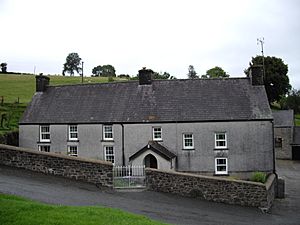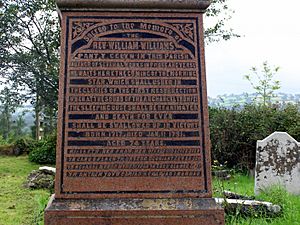William Williams Pantycelyn facts for kids
Quick facts for kids
William Williams Pantycelyn
|
|
|---|---|
 |
|
| Born | 11 February 1717 Llanfair-ar-y-bryn |
| Died | 11 January 1791 Pantycelyn Farmhouse |
William Williams, known as Pantycelyn, was a very important person in Wales from 1717 to 1791. He is famous for writing many hymns, which are religious songs. People consider him Wales's best hymn writer. He was also a great writer of poetry and other books.
In his religious life, he was a key leader in the Welsh Methodist revival during the 1700s. He worked alongside other important preachers like Howell Harris and Daniel Rowland.
Contents
Life Story of William Williams
William Williams was born in 1717 at Cefn-coed farm. This farm was in a place called Llanfair-ar-y-bryn, near Llandovery in Carmarthenshire, Wales. His parents were John and Dorothy Williams.
His father, John, passed away in 1742. Later, his mother, Dorothy, moved to a nearby farm called Pantycelyn. This is why William Williams is often called "Pantycelyn."
His family were Nonconformists. This means they were Protestants who did not follow the official Church of England. William went to school locally and then to a Nonconformist academy. He first planned to study medicine.
However, in 1737 or 1738, his life changed. He heard the preacher Howell Harris speak in Talgarth. This experience made him decide to dedicate his life to religion.
William Williams lived most of his life in the Llanfair-ar-y-bryn area. He died at Pantycelyn in January 1791 when he was 74 years old. He is buried in the churchyard of Llanfair-ar-y-bryn. There is also a special chapel in Llandovery that remembers him.
William Williams as a Religious Leader
William Williams felt a strong calling to become a priest. In 1740, he joined the Anglican Church, even though his family were Nonconformists. At that time, the Anglican Church was the official state religion. Today, it is known as the Church in Wales.
His first job was helping a priest named Theophilus Evans. He worked in the parishes of Llanwrtyd, Llanfihangel Abergwesyn and Llanddewi Abergwesyn. Around this time, he became involved in the Methodist movement.
Methodism and the Church
Methodism started as a group within the Church of England that wanted to make changes. It was not meant to be a separate church at first. But some people in the Anglican Church saw it as a threat. In 1742, some people complained about Williams's Methodist activities.
In 1743, Williams wanted to become a full priest. But his request was turned down because of his connection to the Methodists. Instead of a quiet life as an Anglican priest, he chose to be a Methodist preacher. This was a harder path, often with less money, but it was what he believed in.
The Methodist movement in Wales started even before the famous brothers Charles and John Wesley began their work in England. Welsh Methodism began around 1735 with leaders like Howell Harris and Daniel Rowland. Most Welsh Methodists followed a teaching called Calvinism. This was different from John Wesley's teachings, which led to some disagreements later on.
In 1811, the Welsh Calvinist Methodists decided to separate from the Anglican Church. They started their own church, now called the Presbyterian Church of Wales. They also began to ordain their own ministers. William Williams Pantycelyn would likely have supported these changes. He strongly believed in Calvinist teachings.
Preaching Across Wales
William Williams Pantycelyn traveled all over Wales. He preached the ideas of Calvinistic Methodism. Some say he even sold tea to help support his work. He was not just a preacher; he also helped organize the new Methodist groups.
His followers met in special fellowship meetings called seiadau (pronounced "say-eye-dye"). Williams had to set up and then keep these seiadau going as he traveled. Every time he visited a new place and found new followers, a new seiat was needed.
This work was very demanding, but it was also very rewarding. He saw the Methodist community grow and become strong. He knew he had chosen a meaningful life, different from being a priest in a small country church.
William Williams "Pantycelyn" is remembered as a key leader of the Methodist Revival in Wales. He was also the main writer and voice of that movement.
William Williams as a Literary Figure

William Williams Pantycelyn was important not only for religion in Wales but also for Welsh language culture. His influence lasted through the 1800s and 1900s. He is especially known for writing hymns. Because of his amazing ability, people called him y pêr ganiedydd, which means 'The Sweet Songster'. This name is similar to how King David was called "the sweet psalmist of Israel" in the Bible.
Famous Hymns
Most of his writings were in his native Welsh, but he also wrote some in English. His first work was published in 1744. It was the first part of Aleluia, a collection of Welsh hymns. He published many more collections after that:
- 1751: Hosanna i Fab Dafydd (Hosannah to the Son of David).
- 1759: Rhai hymnau a chaniadau duwiol (Some hymns and divine songs).
- 1762: Caniadau y rhai sydd ar y môr o wydr (The songs of those on the crystal sea).
- 1763: Ffarwel weledig, groesaw anweledig bethau (Farewell seen, and welcome unseen things).
- 1771: Gloria in excelsis.
- 1772: O'er the Gloomy Hills of Darkness.
- 1774: Ychydig hymnau (A few hymns).
- 1782: Rhai hymnau newyddion (Some new hymns).
He also published two collections of English hymns:
- 1759: Hosannah to the son of David.
- 1772: Gloria in excelsis.
His most famous hymn is "Arglwydd, arwain trwy'r anialwch". In English, this means "Lord, lead thou through the wilderness." It was quickly translated into English as "Guide Me, O Thou Great Jehovah" or "Guide Me, O Thou Great Redeemer." This hymn is often sung to the well-known tune Cwm Rhondda.
Poetry and Other Writings
Besides hymns, William Williams wrote two long poems about religious ideas:
- 1756: Golwg ar deyrnas Crist (A view of Christ's kingdom). This poem was about the history of salvation.
- 1764: Bywyd a marwolaeth Theomemphus (Life and death of Theomemphus). This poem explored the experience of becoming a Christian and living a Christian life.
He also wrote poems to remember other important Christian leaders who had passed away.
Williams wrote many prose works, which are like essays or books. He also translated some works from English. Most of these writings were meant to help the members of the Methodist groups he started.
He wrote about a religious revival that happened in 1762:
- 1762: Llythyr Martha Philopur at y Parchedig Philo Evangelius eu hathro (Martha Philopur's letter to the Reverend Philo Evangelius her teacher).
- 1763: Atteb Philo-Evangelius i Martha Philopur (Philo-Evangelius's reply to Martha Philopur).
These books explained the meaning of the 1762 revival at Llangeitho. During this revival, some Methodists in Wales were known as Jumpers because of their strong physical reactions.
He also wrote practical guides to help people live a Christian life:
- 1777: Doctor Nuptarum neu gyfarwyddwr priodas (Teacher of the Nuptials or the marriage guide).
- 1777: Drws y society profiad (A gateway to the experience meeting).
These guides were for the new members of the seiadau or societies.



